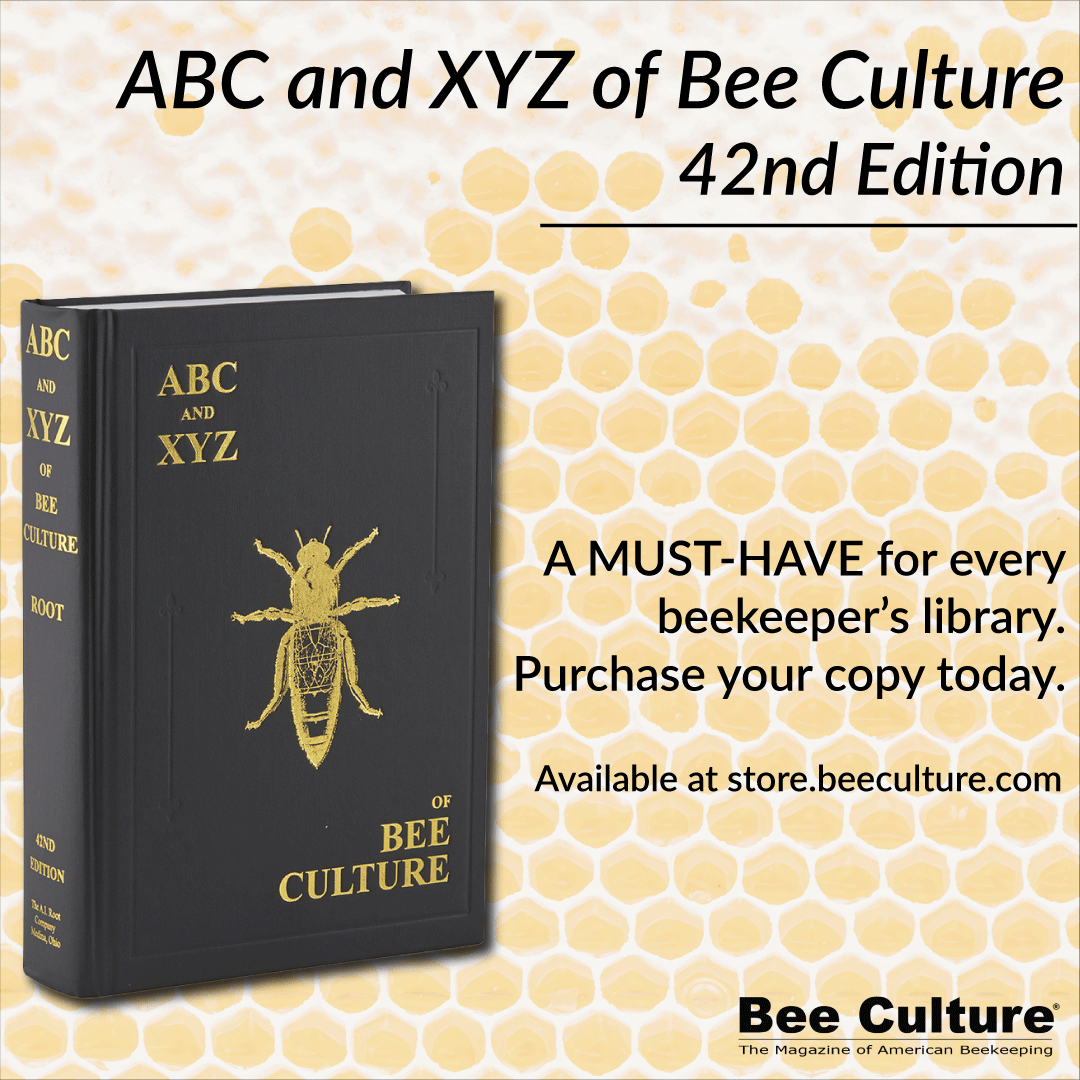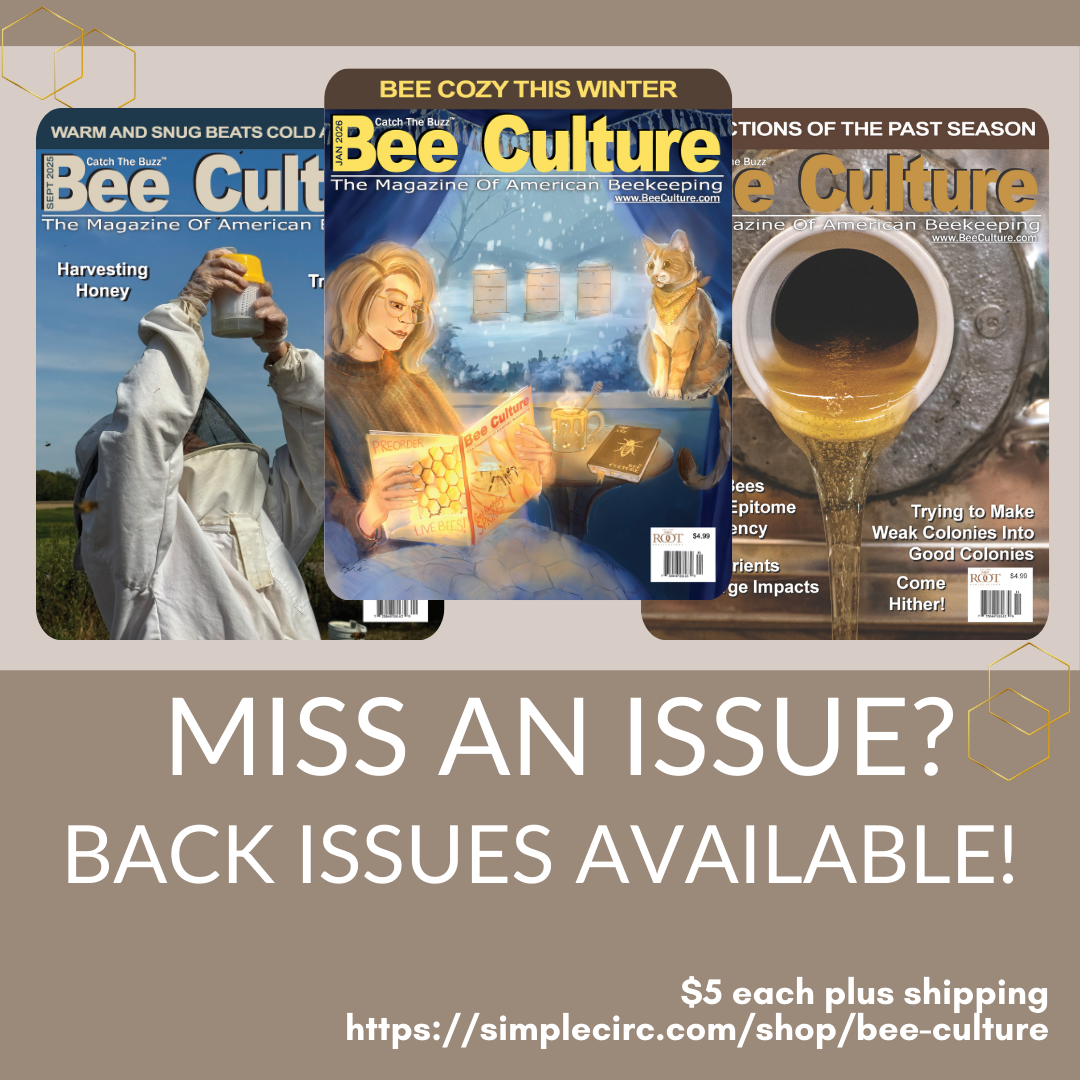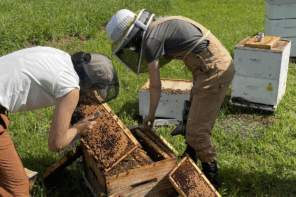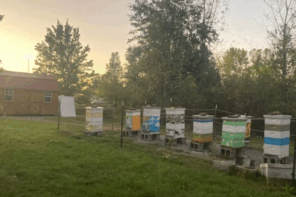By: Ross Conrad
This article originally appeared in the Spring 2020 issue of BEEKeeping Your First Three Years
Early in American history it was decided that the best response to false, misleading and untruthful information was not to censor, but the Bill of Rights and the First Amendment that guarantees the right to more speech to correct and expose the lack of credibility of those who spread incorrect information for personal gain.
The December 3, 2019 Catch the Buzz installment Neonic Crisis Counter Point by Jon Entine titled “Challenging media narrative about the ‘birds and the bees'” – neither faces serious threats from neonicotinoids or other crop chemicals, was quite astounding. Not because it shed new light and helped to inform readers about the reality of our current situation, but because it included a few verifiable facts mixed in with a large number of inaccuracies, misinformation and a one-sided argument that ignored or disregarded the voluminous facts that do not fit into the narrative Entine espouses.
Find a fault and use it to discredit all other information.
Entine seizes on the truth that some environmental groups and numerous media outlets have erroneously claimed that honey bees are going extinct. Such statements either misunderstand the situation or overly hype it up in order to grab peoples’ attention. Entine correctly points out that the number of honey bees worldwide has increased over the last decade while ignoring the fact that at the same time, Winter and yearly losses among beekeepers are also are record high levels. The reason honey bee colony numbers have increased is because beekeepers are absorbing these losses and have gotten used to replacing their high annual losses by buying bees or creating splits and nucleus colonies.
Play fast and loose with the facts.
As a former producer and director for both NBC and ABC news, the number of facts that Mr. Entine gets completely wrong is impressive. As the Executive Director of the Genetic Literacy Project whose motto is “Science not ideology”, Entine’s lack of scientific references of peer reviewed studies to back up his assertions and claims, even when he refers to such studies, speaks to the weakness of his arguments. For example, he claims that studies on the dangers of lmidacloprid are misguided because most com and soybean seeds are treated with clothianidin and thiamethoxam which are tens of times less toxic to birds. Not only do we know that clothianidin is the most toxic of all the neonicotiniods (Pisa, 2015), but he ignores the fact that birds also eat insects that have ingested the toxins and this allows the poisons to bioaccumulate in the birds some of whom are not primarily seed eaters. The bioaccumulation process occurs when a chemical or metal becomes increasingly concentrated as it moves up through a food chain.
The “Counterpoint” states that “Within a few years after the introduction of neonicotinoid seed treatments, they were celebrated almost as a miracle insecticide as they reduced the overall toxicity of pesticide use and had few if any documentable impacts on non-target species.” (emphasis added) True but the reduced toxicity only applies to mammals such as humans. Neonics are extremely toxic to insects and the only reason few documentable impacts on non-target species existed is because this class of pesticide was so new, the necessary research had not yet been done to see how extensive nontarget impacts might be.
Alternative Facts
Entine’s narrative states categorically that unlike other pesticides, neonicotinoids do not “kill beneficial insects, threaten wildlife and pose health problems to humans”. Such statements are simply without merit and not supported by the evidence. The reality is that “Major knowledge gaps remain, but current use of neonicotinoids is likely to be impacting on a broad range of non-target taxa including pollinators and soil and aquatic invertebrates and hence threatens a range of ecosystem services (Goulson, 2013). In other areas, we just don’t know one way or another if neonics are really safe.
Here are some direct quotes from the science:
“We found honey bees in both control and neonicotinoid-treated groups progressed almost identically through the Summer and Fall seasons and observed no acute morbidity or mortality in either group until the end of Winter. Bees from six of the twelve neonicotinoid treated colonies had abandoned their hives, and were eventually dead with symptoms resembling CCD. However, we observed a complete opposite phenomenon in the control colonies in which instead of abandonment, they were re-populated quickly with new emerging bees.” (Chensheng, 2014)
“Our study on honey bees under laboratory conditions confirmed the lethality of clothianidin to honey bees at high doses. We could as well show that individual honey bees fed with sub-lethal doses (30 pg to 3000 pg per bee) revealed inhibitory effects on conditioning responses…” (Bartling, 2019)
“Two studies, conducted on different crops and on two continents, now substantiate that neonicotinoids diminish bee health…Tsvetkov et al. find that bees near corn crops are exposed to neonicotinoids for three to four months via nontarget pollen, resulting in decreased survival and immune responses, especially when coexposed to a commonly used agrochemical fungicide. Woodcock et al., in a multicounty experiment on rapeseed in Europe, find that neonicotinoid exposure from several nontarget sources reduces overwintering success and colony reproduction in both honey bees and wild bees. These field results confirm that neonicotinoids negatively affect pollinator health under realistic agricultural conditions.” (Woodcock, 2017)

Pesticides would rank near the bottom of the list of problems bees have to worry about if these toxic chemicals didn’t exasperate the issues of Varroa, diseases, nutrition, and forage availability by making them all worse.
“Species foraging on oilseed rape benefit from the cover of this crop, but were on average three times more negatively affected by exposure to neonicotinoids than non-crop foragers. Our results suggest that sub-lethal effects of neonicotinoids could scale up to cause losses of bee biodiversity.” (Woodcock 2016)
“Neonicotinoids can persist and accumulate in soils. They are water soluble and prone to leaching into waterways. Being systemic, they are found in nectar and pollen of treated crops. Reported levels in soils, waterways, field margin plants and floral resources overlap substantially with concentrations that are sufficient to control pests in crops, and commonly exceed the LC50 (the concentration which kills 50% of individuals) for beneficial organisms. Concentrations in nectar and pollen in crops are sufficient to impact substantially on colony reproduction in bumblebees. (Goulson, 2013)
“Results demonstrate that imidacloprid has direct effects on white-tailed deer when administered at field-relevant doses.” (Berheim, 2019) The white-tailed deer fawns in this study suffered malformations and higher death rates when imidacloprid, was added into their drinking water. Researchers also showed that when higher levels of imidicloprid accumulated in the spleen of the deer, both body weight and survival of fawns decreased.
In 2016 a systematic review of all available peerreviewed research was conducted on the human health effects of neonicotinoids. Reviewers concluded that “the studies conducted to date were limited in number with suggestive but methodologically weak findings related to chronic exposure. Given the wide-scale use of neonics, more studies are needed to fully understand their effects on human health.” (Cimino 2017)
Another review states: “Due to the broad application of neonicotinoids, a widespread human exposure to these pesticides can be suggested. Present evidence from epidemiological studies, in vivo and in vitro studies indicates that neonicotinoids cause potential damage to humans and mammals. However, methods for determining damage from neonicotinoids in human biological samples are still in the research stage and deserve further investigation. At the same time, large-scale prospective studies are needed to see whether neonicotinoids will have deleterious effects on humans, especially among vulnerable populations such as occupational groups, children, and pregnant women. (Han, 2017)
Australia’s Example
Entine echoes other pesticide industry apologists by bringing up the fact that no reports of CCD have been confirmed in Australia, despite that country using neonicotinoid pesticides for years. I checked on this claim about two years ago and found that Australian beekeeper experiences do not at all prove that neonics are not a problem for bees down under.
Annual losses had spiked for those beekeepers with apiaries near commercial farming operations, particularly that grow canola. However, it is possible that things may have changed in the past two years so I contacted Des Cannon, former president of the Australia Beekeeper Federation, and former editor of The Australasian Beekeeper again to get an update on the situation in Australia. He contacted knowledgeable beekeepers in almost every Australian state and here is what he said:
“Interestingly, across the group, they had all reduced their losses over, say, 10 years ago, by placing more emphasis on their queens and on maintaining strong hives, often by using nucleus hives for support. Canola was universally seen as a problem, and often avoided. Whether this was due to neonic seed coatings or indiscriminate use of other insecticides was unclear, but all felt fungicides were a bigger issue than previously recognized, especially when used in tank mixes and/or with adjuvants…
“Last thing I would add is that across Australia generally, the bulk of honey production is from native flora. We are far less reliant on agricultural areas than countries overseas, as a lot of that native flora is in public lands such as State forests, National Parks, or Travelling Stock Reserves (which are, in effect, remnant floral habitat and are often grazed by livestock but never cropped). This is why the loss of natural resources in this year’s fires is of such concern. One fire alone has caused a NSW beekeeper to lose 28 apiary sites which had at least 9 or 10 honey producing tree species on them. So in summary, I would say beekeepers still see neonics and insecticides generally as problems, but avoid the problems by not working in the vicinity of Canola or other crop country.”
While Australia’s experience does not exonerate or indict neonics as an issue for honey bees, it is clear that something associated with Canola plantings, has indeed become a problem in agriculturally intensive areas of the land down under. Unlike in the USA, Aussie beekeepers have so far been able to find alternative foraging areas filled with wild native plants and free of pesticide treated crops to help keep their bees in a healthy state. And like many in the U.S., they are cannibalizing healthy nucleus colonies in order to prop up full-size hives. Why are beekeepers not asking why the extra work and cost of keeping nucleus colonies as support for existing hives is needed these days when it was not necessary just 20-30 years ago?
Repeat a lie often enough and many people will believe.
Entine’s article also perpetuates the falsehood that is often repeated even by well-meaning members of the beekeeping community, that “pesticides ranked near the bottom of the list” of challenges that honey bees face. As I have pointed out before, pesticides actually rank near the top of the list when one considers that besides the direct effect these poisons have on the bees, they are able to aggravate all the other issues bees are dealing with. By weakening the bee’s immune system, they make bees more vulnerable to diseases and to Varroa mites, since it is the pathogens that are ubiquitous in colonies weakened by Varroa mites that actually kill the bees, not the mites themselves. Not only are hives weakened by pesticide exposure more likely to die from mite exposure, some pesticides have been shown to increase the time bee brood develops from egg to adult, allowing mites more time to raise their young to maturity. Herbicide use tends to decrease the amount of blossoming plants available to foragers effecting colony nutrition. So we see that pesticides (insecticides, fungicides, herbicides, etc.) make the problems of pathogens, Varroa mites and forage availability all worse.
Older chemicals worse, or better?
Another misleading half-truth that the Entine article perpetuates is the idea that neonicotinoids have replaced the older more toxic chemicals that used to be used. While it is true that the older organophosphates and pyrethrins appear to be more toxic to people than neonicotinoids, the neonics are much more toxic to insects than the older pesticides. Because of the danger to themselves, farmers tended to only use the older poisons when they had to. The relative safety of the neonicotinoids and ease of use by treating seeds and not having to spray, has resulted in farmers using them annually as a matter of course, whether they have a pest problem or not. This is partly responsible for the dramatic increase in pesticide use we have seen in agriculture over the last couple decades. Additionally, the older chemicals were not systemic, so pollinator exposure could be reduced by spraying when crops were not blossoming, or spraying at night or during cold weather when bees were not flying. Should any pollinator visit treated plants following the application of neonics, the systemic and long-lasting nature of this family of pesticides guarantees that the pollinator will be exposed to the pesticide since it readily migrates to the pollen and nectar as well as the rest of the plant. The reality is that not just the pollinators, but we all would benefit from a return to the older “more dangerous” chemicals since it would likely result in a significant decrease in the amount of toxins we spread over our land on an annual basis.
Another half-truth and misleading statement published in the Neonic Crisis Counterpoint article is that concerns that “all insects, bees included, face extinction” is false. This is obviously hard to prove false and argue with and on the face of it is true. What is not mentioned is that scientists have confirmed that the level of species extinction we are experiencing on Earth today, rivals the extinction that occurred during the time of the dinosaurs. Things are so bad researchers have coined the phrase “Sixth mass extinction” to define our time where, by some estimates, the majority of species on the planet will no longer exist by the end of the century. (Pimm, 2000; Thomas, 2004; Wake, 2008; Barnosky, 2011; Wagler, 2012; Ceballos, 2015; Kolbert, 2015) Sure not all insects face extinction but it appears most do, even though some species appear able to increase in population at least temporarily by inhabiting the ecological niche that is opened up by those species that are dying out. (McKinney, 1999) Now I am not claiming that the use of pesticides is the cause of the massive loss of biodiversity we are seeing on our planet at this time, but the evidence certainly suggests that these chemicals are part of the problem. (Hayes, 2010)
I could go on, but you get the picture. Perhaps the fact that Jon Entine’s Genetic Literacy Project is focused primarily on extolling the benefits of Genetic Engineering and downplaying its problems helps explain his desperate defense of neonicotinoids. After all, most genetically modified seeds are treated with neonics and almost all are grown with the aid of glyphosate (Roundup) (Perry, 2016). Thus, the bad rap that pesticides are getting does not reflect well on GMOs. Unfortunately, in his haste to defend GMOs and neonics, Entine sacrifices his credibility by exposing his lack of journalistic integrity and distorting the facts on the ground by not even trying to communicate all the evidence in a truthful and forthcoming manner. This self-proclaimed “journalist” even misidentified the country in which the bird study he bashes (Eng, 2017) was carried out, and as one commenter on his website points out about Entine’s article, “You can’t expect people to believe your proposition if you get details like that wrong.”
References:
Barnosky, A., Matzke, N., Tomiya, S. et al. (2011) Has the Earth’s sixth mass extinction already arrived? Nature 471, 51-57; doi:10.1038/nature09678
Bartling, M.T., Vilcinskas, A., Lee, K. (2019) Sub-Lethal Doses of Clothianidin Inhibit the Conditioning and Biosensory Abilities of the Western Honey bee Apis mellifera, Insects 10 (10): 340
Berheim, E.H., Jenks, J.A., Lundgren, J.G., Michel, E.S., Grove, D., Jensen, W.F. (2019) Effects of Neonicotinoid Insecticides on Physiology and Reproductive Characteristics of Captive Female and Fawn White-tailed Deer, Scientific Reports, 9, 4534 (2019) doi:10.1038/ s41598-019-40994-9
Ceballos, G., Ehrlich, P.R., Barnosky, A. D., Garcia, A., Pringle, R. M., Palmer, T. M. (2015) Accelerating modern human-induced species losses: Entering the sixth mass extinction, Science Advances, Vol. 1, No. 5: e1400253 DOI: 10.1126/sciadv.1400253
Chensheng, L., Warchol, K. M., Callahan, R. A. (2014) Sub-lethal exposure to neonicotinoids impaired honey bees winterization before proceeding to colony collapse disorder, Bulletin of lnsectology: 67 (1): 125-130, 2014 ISSN 1721-8861
Cimino AM, Boyles AL, Thayer KA, Perry MJ. 2017. Effects of neonicotinoid pesticide exposure on human health: a systematic review. Environ Health Perspective 125:155-162; http://dx.doi.org/10.1289/EHP515
Eng, M. L., Stutchbury, B. J. M., Morrissey, C. A. (2017) Imidacloprid and chlorpyrifos insecticides impair migratory ability in a seed-eating songbird, Scientific Reports, 7: 15176 DOI: 10.1038/s41598-017-15446-x
Entine, Jon (2019) Challenging media narrative about the ‘birds and the bees’ – neither faces serious threats from neonicotinoids or other crop chemicals, Genetic Literacy Project https://geneticliteracyproject.org/2019 /11/19/challenging-the-media-narrative-about-the-birds-and-the-bees-neither-of-them-faceserious-threats-from-neonicotinoids-or-other-cropchemicals/
Goulson, Dave (2013) Review: An overview of the environmental risks posed by neonicotinoid insecticides, Journal of Applied Ecology, https://doi.org/10.11111/1365-2664.12111
Han, W., Ying, T., Xiaoming, S (2017) Human exposure to neonicotinoid insecticides and the evaluation of their potential toxicity: An overview, Chemosphere, 192: 59-65
Hayes, T. B., Falso, P., Gallipeau, S., Stice, M. (2010) The cause of global amphibian declines: a developmental endocrinologist’s perspective, Journal of Experimental Biology, 213: 921-933; doi: 10.1242/jeb.040865
Kolbert, Elizabeth (2015) The Sixth Extinction: An Unnatural History, Publisher: Picador, Reprint Edition
Matheson A. (1995). First documented findings of Varroa jacobsoni outside its presumed natural range. Apiacta, 30, 1-8.
McKinney, M. L., Lockwood, J. L. (1999) Biotic homogenization: a few winners replacing many losers in the next mass extinction, Trends in Ecology and Evolution, 14: 11, 450-453
Neumann P., & Carreck N. L. (2010). Honey bee colony losses. Journal of Apicultural Research, 49, 1-6. https://doi.org/10.3896/IBRA.1.49.1.01
Perry, E. D., Ciliberto, F., Hennessy, D. A., Moschini, G.C. (2016) Genetically engineered crops and pesticide use in U.S. maize and soybeans, Science Advances; Vol. 2, no. 8, e1600850 DOI: 10.1126/sciadv.1600850
Pimm, S., Raven, P. (2000) Extinction by numbers. Nature 403, 843-845; DOI: 10.1038/35002708
Pisa, L.W., Amaral-Rogers, V., Belzunces, L.P., Bonmatin, J.M., Downs, C.A., Goulson, D., Kreutzweiser, D.P., Krupke, C., Liess, M., McField, M., Morrissey, C.A., Noome, D.A., Settele, J. Simon-Delso, N., Stark, J.D., Van der Sluiis, J.P., Van Dyck, H., Wiemers, M., (2015) Effects of neonicotinoids andfipronil on non-target invertebrates, Environ Sci Pollut Res 22:68-102 DOI: 10.1007 /s11356-014-3471-x
Seidler, Ramon, J., Bronner, D. (2014) Pesticide use on genetically engineered crops, and Addendum: Traditional Soil-Applied Insecticides are Surging Alongside Neonicotinoid insecticides on Genetically Engineered Corn, Former Senior Scientist (Seidler) at the Environmental Protection Agency Office of Research and Development, Western Ecology Division in Corvallis, OR, https: //static.ewg.org/agmag/pdfs/pesticide_use_on_genetically _ engineered_crops. pdf
Thomas, C., Cameron, A., Green, R. et al. (2004) Extinction risk from climate change. Nature 427, 145-148; DOI: 10.1038/nature02121
Wagler, Ron (2012) The Sixth Great Mass Extinction, Science Scope, Vol. 35, No. 7
Wake, David B., Vredenburg, Vance, T., (2008) Are we in the midst of the sixth mass extinction? A view from the world of amphibians, Proceedings of the National Academy of Sciences, 105 (Supplement 1) 11466-11473; DOI: 10.1073/pnas.0801921105
Woodcock, B.A., Isaac, N.J.B., Bullock, J.M., Roy, D.B., Garthwaite, D.G., Crowe, A, Pywell, R.F. (2016) Impacts of neonicotinoid use on long-term population changes in wild bees in England, Nature Communications 7, 12459 DOI: 10.1038/ncomms12459
Woodcock, B.A., Bullock, J.M., Shore, R.F., Heard, M.S., Pereira, M.G., Redhead, J., Ridding, L., Dean, H., Sleep, D., Henrys, P., (2017). Country-specific effects of neonicotinoid pesticides on honey bees and wild bees. Science 356, Issue 6345, pp. 1393-1395. DOI: 10.1126/science.aaa1190









